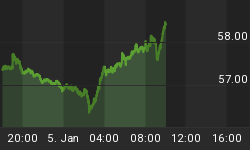Below is an extract from a commentary originally posted at www.speculative-investor.com on 26th March 2006.
The attempts of modern statisticians to create an index that represents the average price in the economy can be likened to the attempts made by the alchemists of old to change non-precious metals into gold. In both cases the idea is appealing, but the objective is impossible.
The impossibility of determining a meaningful number that represents the average price in the economy quickly becomes apparent if we think in terms of the price of money as opposed to the price of a good or a service, that is, if we think in terms of how many things it takes to buy one dollar instead of how many dollars it takes to buy some thing. For example, if the price of an apple is one dollar and the price of a new car is 30,000 dollars and the price of a day's labour is 150 dollars then it can be said that the price of one dollar is one apple in one situation, 1/30000th of a new car in another situation, and 1/150th of a day's labour in yet another situation. So, what is the average of an apple, 1/30000th of a new car and 1/150th of a day's labour? Obviously there isn't one because it makes no sense to calculate the average of totally disparate things. By the same token it is nonsensical to attempt to calculate the average price within the economy.
Following on from the above, it is not possible to determine the effects of inflation by measuring changes in an index that purportedly represents the average price. However, there are many economic statisticians who are as committed to their impossible goal as were the alchemists of ancient times.
The river of futility rises even further, though, because the meaningless numbers that result from attempts to calculate the average price in the economy are adjusted -- ostensibly to make them more representative of the real world -- by taking into account changes in people's buying habits and changes in product quality. With regard to the former, the assumption is made that an increase in the price of beef should not be fully reflected in the price index because some of the people who had been eating beef will avoid paying the higher price by switching to chicken, or pork, or, if need be, dog food; the implication being that a price increase shouldn't count as long as it is possible to substitute a cheaper product for the one whose price is rising. This seems more than a trifle unreasonable to us, but in any case it's the validity of the latter, that is, the validity of adjusting the already-meaningless price indices to account for changes in product quality (a practice known as hedonic adjusting) that we want to deal with today.
The idea behind hedonic adjustments is that if today's product is much better than last year's product then we can't just subtract last year's price from this year's price to determine the effects of inflation; rather, in order to make an 'apples to apples' comparison we must account for the value-adding changes that have been made to the product. To take a specific example, the cars of today are vastly superior to the cars that were being produced in 1950. Therefore, in order to determine what effect inflation has had on the price of a new car over the past 50 years it would make sense, according to those who advocate the use of "hedonic adjustments", to assign a dollar value to all the improvements that have been made over the course of this period and to subtract this allowance from the current price to come up with a hedonically-adjusted current price. It would then be reasonable to compare this (downwardly) adjusted current price to the old price to estimate what effect, if any, inflation has had on the purchasing power of the currency. Right?
Wrong! At first glance there might appear to be some validity to the argument that a product whose price rises by 10% hasn't really experienced a price rise at all if it is now at least 10% better than it was, but note that in a free or even a semi-free economy the natural tendency is for products to get better AND for prices to trend lower. Putting it another way, due to technological advances in particular and productivity gains in general you will, over the long-term, tend to get more for less. Taking the car example mentioned above, if there had been no inflation during the intervening period then the price of a new car today would probably be LESS than the price of a new car in 1950; so the true effect of inflation on the price of a new car would equal the increase in price that has occurred PLUS the amount that the price would otherwise have FALLEN (due to productivity growth and technological advances) in the absence of inflation.
The bottom line is that the "hedonic adjusting" of prices is just another way of hoodwinking people into believing that the effects of inflation are less than they actually are.















